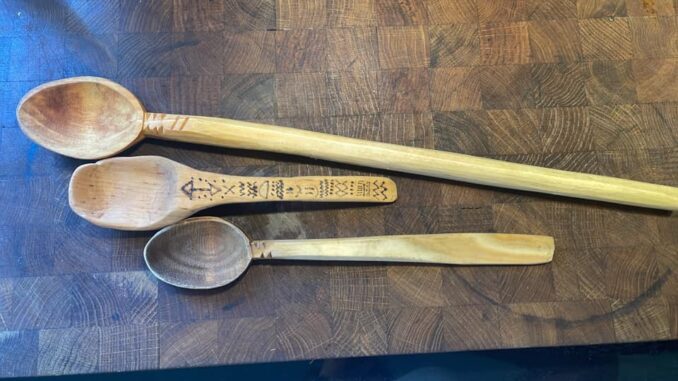
The Romani People have always carved – pardon the pun – out a niche for themselves in regards to business opportunities by making use of the materials at hand, more often than not materials that grew in nature and thus many, although metalworking was also one of the great trades and crafts, made use of wood and other such materials for their crafts from which to make a living. Spoon carving is just one of them.
Spoon carving, in this context, is not just wooden spoons of all kinds, but also stirrers, spatulas and other wooden kitchen tools, including bowls. The styles of spoons, and other utensils, differ often from group to group, from region to region, as are the types of wood used.
The styles are, at times, original styles from this or that group, as they use them themselves, while at other times they are styles that are regional or are those preferred by the customers. Often the traditional group specific styles are just made for own use and other styles are made for sale.
As far as the types of wood that are used are concerned there it is often a story as to what comes to hand and is useful. While many self-proclaimed experts on spoon carving, who have never really done it professionally from the cradle up, as the Rom do, will claim that, for instance, Lime, Poplar, Willow and Pine are not usable as they are not “durable enough” those are often, however, the woods that the professional Romani spoon carvers in Eastern Europe (and elsewhere) use, and they do make their wares for sale to the general public, including chefs.
The Cigano spoon carvers of Portugal do use some varieties of Pine to make their spoons for their own use and for sale though, personally, I have, so far never used Pine even though coming from a spoon carving (and knife making) tradition. I have, however, used Poplar, Willow and Lime, and Willow is, in fact, one of my favorites but it has to be allowed to settle and should not be used “green”, at least not as far as most Willow types are concerned. That is the way it is being done by the Romani carvers and one should assume that they know a thing or two having done it for so long.
The styles of the Rom Polska – and I can only speak for the style of those Rom that I know, the styles that is – from the area of Silesia, that is to say the forests and mountains, the Beskids and the Carpathians, differs from those on the other side, say in Slovakia and from those in Romani, for example, and that significantly.
While a very ancient craft and trade the spoon carvers are still among us today only they can no longer make a real living from their work, as they are being “cheated” by the middlemen. Cheated in that the middlemen, who buy up their spoons for resale, pay the maker a Euro or two per spoon while they sell them far and wide for up to €100.
Once they used to make their spoons and such at their permanent quarters and then went to the local and not so local markets to sell them on market days or they would go about the countryside from village to village selling them door to door. As that kind of trade has become more and more difficult due to red tape they have begun to rely on often not very honest middlemen who do not pay them a real fair prices even though to the poor Rom maker of such items it appear a good deal.
However, because they cannot really make a proper living for themselves and their families from their craft this, and other trades and crafts, are seen as outdated. They are not. The marketing needs to be improved and the model of it – the marketing that is – changed and there also has to be a return to the markets, but especially the special markets.
Working in a kind of cooperative, especially as far as marketing and sales are concerned, could be a way forward and cooperative for Internet sales would be very advantageous in that but one domain name would be needed and paid for if a website could be created that could have a dedicated section for each member of the makers’ cooperative.
A possibility might also be an “Etsy” kind of set up, or similar, for Romani craftspeople of all kinds even, where individual makers have their own section. It can all be done and the traditional crafts and trades can still bring in a living and more if it is done right in the marketing and sales department.
Michael Smith
redaktionen@dikko.nu
Att vara en oberoende tidning kostar pengar så vill du hjälpa oss med att betala vårt fika får du gärna swisha en slant till 123 242 83 40 eller bg: 5534-0046
Vill du annonsera eller sponsra, synas eller höras i våra media?
Kontakta oss på redaktionen@dikko.nu
eller ring 0768 44 51 61
IBAN: SE19 9500 0099 6042 1813 4395
BIC: NDEASESS




